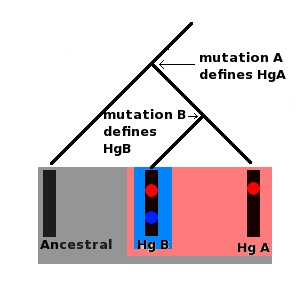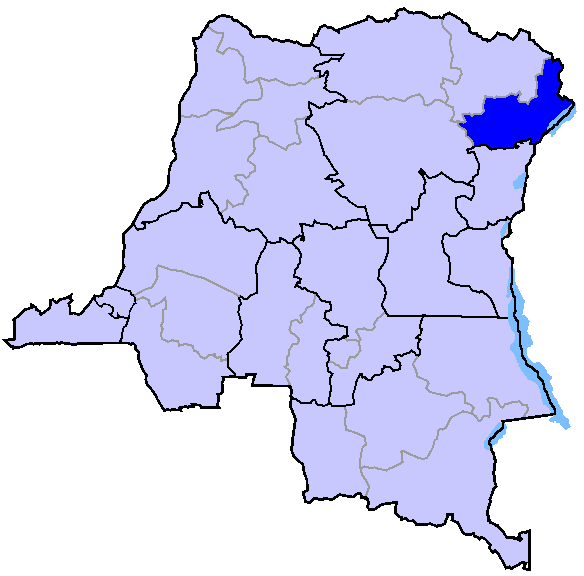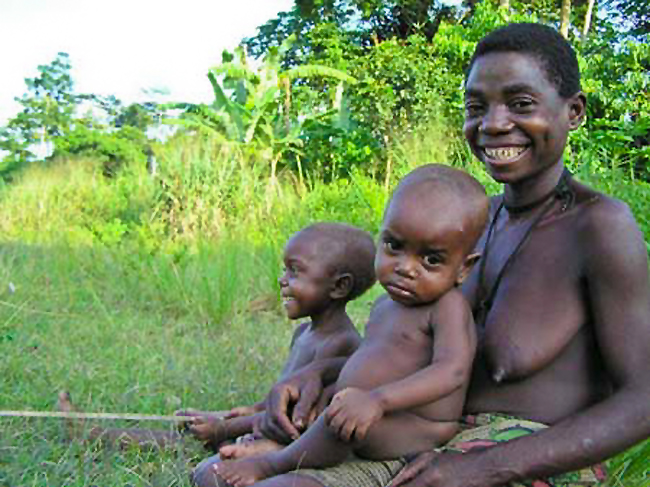|
Haplogroup L5 (mtDNA)
Haplogroup L5 is a human mitochondrial DNA (mtDNA) clade. It was previously known as L1e. Distribution L5 is a small haplogroup centered in East Africa. The highest frequency is in Mbuti Pygmies from Eastern Central Africa at 15%. It is present in relatively small frequencies in Tanzania ( Sandawe and others), Kenya, Chad, Ethiopia, Sudan, Nubia, EgyptSample UPE52 is subclade L5a. and Saudi Arabia. Haplogroup L5 has been observed among specimens at the island cemetery in Kulubnarti, Sudan Sudan ( or ; ar, السودان, as-Sūdān, officially the Republic of the Sudan ( ar, جمهورية السودان, link=no, Jumhūriyyat as-Sūdān), is a country in Northeast Africa. It shares borders with the Central African Republic t ..., which date from the Early Christian period (AD 550–800). Subclades Tree This phylogenetic tree of haplogroup L5 subclades is based on the paper by Mannis van Oven and Manfred Kayser ''Updated comprehensive phylogenetic tree of global human ... [...More Info...] [...Related Items...] OR: [Wikipedia] [Google] [Baidu] |
Human Mitochondrial DNA Haplogroup
In human genetics, a human mitochondrial DNA haplogroup is a haplogroup defined by differences in human mitochondrial DNA. Haplogroups are used to represent the major branch points on the mitochondrial phylogenetic tree. Understanding the evolutionary path of the female lineage has helped population geneticists trace the matrilineal inheritance of modern humans back to human origins in Africa and the subsequent spread around the globe. The letter names of the haplogroups (not just mitochondrial DNA haplogroups) run from A to Z. As haplogroups were named in the order of their discovery, the alphabetical ordering does not have any meaning in terms of actual genetic relationships. The hypothetical woman at the root of all these groups (meaning just the mitochondrial DNA haplogroups) is the matrilineal most recent common ancestor (MRCA) for all currently living humans. She is commonly called Mitochondrial Eve. The rate at which mitochondrial DNA mutates is known as the mitochon ... [...More Info...] [...Related Items...] OR: [Wikipedia] [Google] [Baidu] |
East Africa
East Africa, Eastern Africa, or East of Africa, is the eastern subregion of the African continent. In the United Nations Statistics Division scheme of geographic regions, 10-11-(16*) territories make up Eastern Africa: Due to the historical Omani Empire and colonial territories of the British East Africa Protectorate and German East Africa, the term ''East Africa'' is often (especially in the English language) used to specifically refer to the area now comprising the three countries of Kenya, Tanzania, and Uganda. However, this has never been the convention in many other languages, where the term generally had a wider, strictly geographic context and therefore typically included Djibouti, Eritrea, Ethiopia, and Somalia.Somaliland is not included in the United Nations geoscheme, as it is internationally recognized as a part of Somalia. *Tanzania, Kenya, Uganda, Rwanda, Burundi, Democratic Republic of Congo and South Sudan are members of the East African Community. The firs ... [...More Info...] [...Related Items...] OR: [Wikipedia] [Google] [Baidu] |
Nile
The Nile, , Bohairic , lg, Kiira , Nobiin language, Nobiin: Áman Dawū is a major north-flowing river in northeastern Africa. It flows into the Mediterranean Sea. The Nile is the longest river in Africa and has historically been considered the List of rivers by length, longest river in the world, though this has been contested by research suggesting that the Amazon River is slightly longer.Amazon Longer Than Nile River, Scientists Say Of the world's major rivers, the Nile is one of the smallest, as measured by annual flow in cubic metres of water. About long, its drainage basin covers eleven countries: the Democratic Republic of the Congo, Tanzania, Burundi, Rwanda, Uganda, Kenya, Ethiopia, Erit ... [...More Info...] [...Related Items...] OR: [Wikipedia] [Google] [Baidu] |
Haplogroup L2-6 (mtDNA)
In human mitochondrial genetics, L is the Human mitochondrial DNA haplogroup, mitochondrial DNA macro-haplogroup that is at the root of the anatomically modern human (''Homo sapiens'') mtDNA phylogenetic tree. As such, it represents the most ancestral mitochondrial lineage of all currently living modern humans, also dubbed "Mitochondrial Eve". Its two sub-clades are Haplogroup L1-6 (mtDNA), L1-6 and Haplogroup L0 (mtDNA), L0. The split occurred during the Penultimate Glacial Period; L1-6 is estimated to have formed ca. 170 kya, and L0 ca. 150 kya. The formation of L0 is associated with the peopling of Africa, peopling of Southern Africa by populations ancestral to the Khoisan, ca. 140 kya, at the onset of the Eemian interglacial. L is further subdivided into L1-6 and Haplogroup L1 (mtDNA), L1, dated ca. 150 kya and 130 kya, respectively. Haplogroups Haplogroup L5 (mtDNA), L5 (120 kya), Haplogroup L2 (mtDNA), L2 and Haplogroup L6 (mtDNA), L6 (90 kya), Haplogroup L4 (mtDNA), L4 ... [...More Info...] [...Related Items...] OR: [Wikipedia] [Google] [Baidu] |
Haplogroup L5a (mtDNA)
A haplotype is a group of alleles in an organism that are inherited together from a single parent, and a haplogroup (haploid from the el, ἁπλοῦς, ''haploûs'', "onefold, simple" and en, group) is a group of similar haplotypes that share a common ancestor with a single-nucleotide polymorphism mutation. More specifically, a haplogroup is a combination of alleles at different chromosomal regions that are closely linked and that tend to be inherited together. As a haplogroup consists of similar haplotypes, it is usually possible to predict a haplogroup from haplotypes. Haplogroups pertain to a single line of descent. As such, membership of a haplogroup, by any individual, relies on a relatively small proportion of the genetic material possessed by that individual. Each haplogroup originates from, and remains part of, a preceding single haplogroup (or paragroup). As such, any related group of haplogroups may be precisely modelled as a nested hierarchy, in which each set (hapl ... [...More Info...] [...Related Items...] OR: [Wikipedia] [Google] [Baidu] |
Haplogroup L5c (mtDNA)
A haplotype is a group of alleles in an organism that are inherited together from a single parent, and a haplogroup (haploid from the el, ἁπλοῦς, ''haploûs'', "onefold, simple" and en, group) is a group of similar haplotypes that share a common ancestor with a single-nucleotide polymorphism mutation. More specifically, a haplogroup is a combination of alleles at different chromosomal regions that are closely linked and that tend to be inherited together. As a haplogroup consists of similar haplotypes, it is usually possible to predict a haplogroup from haplotypes. Haplogroups pertain to a single line of descent. As such, membership of a haplogroup, by any individual, relies on a relatively small proportion of the genetic material possessed by that individual. Each haplogroup originates from, and remains part of, a preceding single haplogroup (or paragroup). As such, any related group of haplogroups may be precisely modelled as a nested hierarchy, in which each set (hapl ... [...More Info...] [...Related Items...] OR: [Wikipedia] [Google] [Baidu] |
Mbuti
The Mbuti people, or Bambuti, are one of several indigenous pygmy groups in the Congo region of Africa. Their languages are Central Sudanic languages and Bantu languages. Subgroups Bambuti are pygmy hunter-gatherers, and are one of the oldest indigenous people of the Congo region of Africa. The Bambuti are composed of bands which are relatively small in size, ranging from 15 to 60 people. The Bambuti population totals about 30,000 to 40,000 people. Many Batwa in various parts of the DRC call themselves Bambuti as well. There are three distinct subgroups: * The Sua (also Kango, or Mbuti), who speak a dialect (or perhaps two) of the language of a neighboring Bantu people, Bila. They are located centrally and are eponymous of the larger group. * The Efé, who speak the language of the neighboring Central Sudanic Lese. * The Asua, speakers of the Mangbetu (Central Sudanic) Asua language. Environment The Mbuti population live in the Ituri, a tropical rainforest covering a ... [...More Info...] [...Related Items...] OR: [Wikipedia] [Google] [Baidu] |
Pygmies
In anthropology, pygmy peoples are ethnic groups whose average height is unusually short. The term pygmyism is used to describe the phenotype of endemic short stature (as opposed to disproportionate dwarfism occurring in isolated cases in a population) for populations in which adult men are on average less than tall. The term is primarily associated with the African Pygmies, the hunter-gatherers of the Congo Basin (comprising the Bambenga, Bambuti and Batwa). The terms "Asiatic Pygmies" and "Oceanian pygmies" have been used to describe the Negrito populations of Southeast Asia and Australo-Melanesian peoples of short stature. The Taron people of Myanmar are an exceptional case of a "pygmy" population of East Asian phenotype. Etymology The term ''pygmy'', as used to refer to diminutive people, derives from Greek πυγμαῖος ''pygmaios'' via Latin ''Pygmaei'' (sing. ''Pygmaeus''), derived from πυγμή – meaning a short forearm cubit, or a measure of length corres ... [...More Info...] [...Related Items...] OR: [Wikipedia] [Google] [Baidu] |
Sandawe People
The Sandawe are an indigenous ethnic group of Southeast Africa, based in the Chemba District of Dodoma Region in central Tanzania. In 2000, the Sandawe population was estimated to be 40,000. The Sandawe language is a tonal language that uses click consonants, as do the Khoe languages of southern Africa. There is no other proven connection between the two. History Origins Although the Khoisan were originally thought to possess the oldest human DNA lineages, those of the Sandawe are older. This suggests southern Khoisan originated in East Africa. The Sandawe today are considered descendants of an original Bushmen-like people, unlike their modern neighbours, the Gogo. They live in the geographic centre of old German East Africa, the 'Street of Caravans' crossing their southern edge. The Sandawe language may share a common ancestor with the Khoe languages of southern Africa. It has clicks and the surrounding Bantu peoples find it difficult to learn. It is unrelated to the nei ... [...More Info...] [...Related Items...] OR: [Wikipedia] [Google] [Baidu] |
Kulubnarti
Kulubnarti ("Kulb island") is a long island in northern Sudan. Located on the Nile, around south of the Egyptian border, it is part of the village of Kulb. Until the fifteenth century, Kulubnarti was a remote area. It was one of the last known refuges for Christians in Nubia, while Islam spread to the south. It has been inhabited since the time of the Christian kingdom of Makuria, approximately 1100 AD. Continuously inhabited from the eleventh century to modern times, it is the only Nubian location which has demonstrated through archaeologically investigation a continuous occupation from the Middle Ages to modern history. Kulubnarti has archaeological and anthropological significance because it has been subjected to one of the only systematic excavations of any site along the southern portion of the Nile. The primary motivation for excavation at Kulubnarti was to increase awareness and understanding of the cultural transition from Christianity to Islam in ancient Nubia. Nubia conv ... [...More Info...] [...Related Items...] OR: [Wikipedia] [Google] [Baidu] |
Sudan
Sudan ( or ; ar, السودان, as-Sūdān, officially the Republic of the Sudan ( ar, جمهورية السودان, link=no, Jumhūriyyat as-Sūdān), is a country in Northeast Africa. It shares borders with the Central African Republic to the southwest, Chad to the west, Egypt to the north, Eritrea to the northeast, Ethiopia to the southeast, Libya to the northwest, South Sudan to the south and the Red Sea. It has a population of 45.70 million people as of 2022 and occupies 1,886,068 square kilometres (728,215 square miles), making it Africa's List of African countries by area, third-largest country by area, and the third-largest by area in the Arab League. It was the largest country by area in Africa and the Arab League until the 2011 South Sudanese independence referendum, secession of South Sudan in 2011, since which both titles have been held by Algeria. Its Capital city, capital is Khartoum and its most populated city is Omdurman (part of the metropolitan area of Khar ... [...More Info...] [...Related Items...] OR: [Wikipedia] [Google] [Baidu] |






